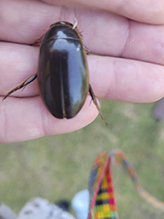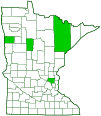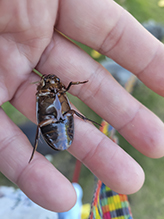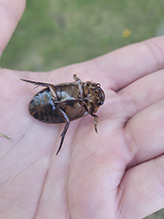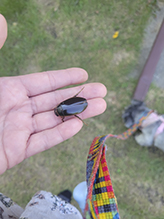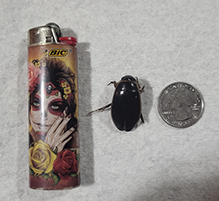Understriped diving beetle
(Dytiscus fasciventris)
Conservation • Description • Habitat • Ecology • Distribution • Taxonomy
Conservation Status |
|||
| IUCN Red List | not listed |
||
| NatureServe |
|
||
| Minnesota |
|
||
Description
Understriped diving beetle is a large water beetle. It occurs in the Unites States from Maine to Minnesota south to Virginia and Missouri, and in adjacent Canadian provinces. It also occurs in western Canada from Alberta to the Yukon, and in Wyoming. It is found in permanent ponds and marshes with sedges. The larvae, called water tigers, are more often among aquatic plants, while the adults are more often in open, deeper water. Both larvae and adults are voracious eaters, preying on aquatic invertebrates and small fish. Larvae also prey on mosquito larvae in the spring.
Adults are ⅞″ to 1⅛″ (22.0 to 27.9 mm) in length. The body is elongated oval, broadest near the middle, and it is streamlined, convex both above and below. It is usually brown or brownish-black, sometimes green. On the underside, the rearmost plate of the thorax (metasternum) is brownish-black in the middle. The underside of the abdomen is mostly brownish-yellow to reddish.
The exoskeletal plate covering the first segment of the thorax (pronotum) has a broad pale stripe on the lateral margin. The front margin has a narrow faint pale stripe, a narrow dark reddish stripe, or no stripe all. The rear margin is never striped. The triangular plate (scutellum) between the bases of the wing covers (elytra) is visible.
The elytra on the female always have distinct parallel groves. On the male the elytra are smooth, polished, and sparsely hairy. On both sexes they completely cover the abdomen and there is a pale stripe on each lateral margin. The stripes narrow beyond the halfway point and disappear before reaching the wingtip.
The mouthparts are directed forward. The antennae are thread-like and have eleven segments. The eyes are not notched above the antennae bases.
The rear legs are flattened and much longer than the front and middle legs. The first segment (coxa) of the hind legs is yellow. The fourth segment (tibia) has two spurs at the tip. The smaller spur is as wide or only slightly wider than the larger spur. The last part of the leg (tarsus), corresponding to the foot, has five segments. On the hind legs, the rear margins of the first four tarsal segments are bare, not fringed with golden hairs. The outer margins of each segment are covered with hairs which aid in swimming. On the front legs of the male, the first three tarsal segments are greatly widened, and together form a nearly circular suction disk.
Size
⅞″ to 1⅛″ (22.0 to 27.9 mm)
Similar Species
Habitat
Permanent ponds and marshes with sedges
Ecology
Season
One generation per year: April to November
Behavior
Adults are very good swimmers. They will come to lights.
Life Cycle
Adults overwinter in permanent waters. They mate in late fall or early spring. The male uses the suction disks on its front legs to hold the female while mating.
Larva Food/Hosts
Mosquito larvae, aquatic invertebrates, and small fish
Adult Food
Aquatic invertebrates and small fish
Distribution |
||
|
Sources Biodiversity occurrence data published by: Minnesota Biodiversity Atlas (accessed through the Minnesota Biodiversity Atlas Portal, bellatlas.umn.edu, 10/8/2025). Roughley, R E. 1990. "A Systematic Revision of Species of Dytiscus Linnaeus |
|
| 10/8/2025 | ||
Occurrence |
||
Common |
||
Taxonomy
Order
Coleoptera (Beetles)
Suborder
Adephaga (Ground and Water Beetles)
Superfamily
Dytiscoidea
Family
Dytiscidae (predaceous diving beetles)
Subfamily
Dytiscinae
Tribe
Dytiscini
Genus
Subordinate Taxa
Synonyms
Common Names
understriped diving beetle
understriped dytiscid diving beetle
Glossary
Elytra
The hardened or leathery forewings of beetles used to protect the fragile hindwings, which are used for flying. Singular: elytron.
Pronotum
The exoskeletal plate on the upper side of the first segment of the thorax of an insect.
Scutellum
The exoskeletal plate covering the rearward (posterior) part of the middle segment of the thorax in some insects. In Coleoptera, Hemiptera, and Homoptera, the dorsal, often triangular plate behind the pronotum and between the bases of the front wings. In Diptera, the exoskeletal plate between the abdomen and the thorax.
Tarsus
On insects, the last two to five subdivisions of the leg, attached to the tibia; the foot. On spiders, the last segment of the leg. Plural: tarsi.
Tibia
The fourth segment of an insect leg, after the femur and before the tarsus (foot). The fifth segment of a spider leg or palp. Plural: tibiae.
Visitor Photos
Share your photo of this insect.
This button not working for you?
Simply email us at info@MinnesotaSeasons.com.
Attach one or more photos and, if you like, a caption.
MinnesotaSeasons.com Photos
|

Slideshows

Visitor Videos
Share your video of this insect.
This button not working for you?
Simply email us at info@MinnesotaSeasons.com.
Attach a video, a YouTube link, or a cloud storage link.
Other Videos

Visitor Sightings
Report a sighting of this insect.
This button not working for you?
Simply email us at info@MinnesotaSeasons.com.
Be sure to include a location.
Mkolve74
11/3/2025
Location: Eleva, Wisconsin
Shylo Morgan
8/23/2021
Location: Ada, MN
First of all I love your site.
Can you tell me what kind of bug this is? I assume it's a beetle but I've never seen one like this. Or this huge.
I seen my first ever cicada last year. I was reading after males mate they just kinda Drop dead. 😄 Is that what happened here?
Minnesota Seasons Sightings

